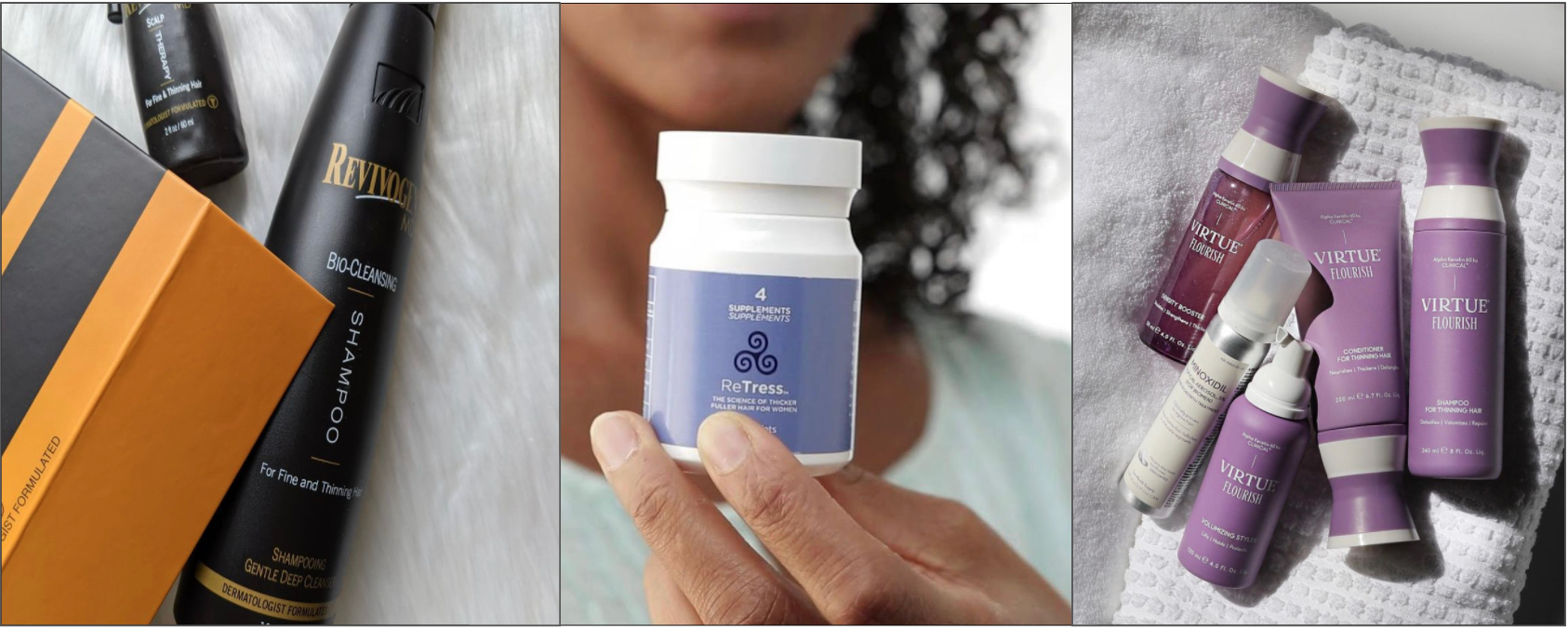Few things related to beauty are more frustrating than female hair loss or hair thinning. The symptoms of female hair loss can often go unnoticed for quite some time, and although there are no real ways to prevent clinical hair loss, there are ways to address it once it begins. Here are 12 facts and statistics about female hair loss to give you a better idea of what the symptoms are, and to help you better understand your diagnosis once it comes.
Fact 1: Hair loss is normal.
Don’t panic if you see a few strands of hair in your shower or stuck in your brush – everyone sheds hair everyday as a part of normal body function. “Women tend to lose between 50 and 100 hairs per day, which is a level of hair shedding that would not constitute a diagnosis for clinical female hair loss, often known as alopecia,” says Dr. Parks, founder of DermWarehouse.
Natural hair shedding is different from clinical hair loss, which is often diagnosed as “alopecia” or pattern hair loss (male or female) and can be caused by things like genetics, medications or menopause. A little bit of hair in your brush or comb is nothing to worry about, but if you notice that excess hair is starting to fall out or feel that your hair is not being replaced as it falls out, that could be a sign of female hair loss. [source: American Academy of Dermatology Association]
Fact 2: Heredity is the most common cause of female hair loss, but less so than in men.
If you’re experiencing hair loss, it’s not necessarily something wrong that you’re doing in your routine. Like many skin and hair conditions, you may have inherited hair loss from your family. “Genetics are the most common cause of female hair loss in both men and women. Around 80% of hair loss in men is hereditary, though there is some evidence to show that that number may be different in female pattern hair loss,” says Dr. Parks.
A 2017 study published in the British Journal of Dermatology discusses the differences between female and male pattern baldness, particularly whether or not they share similar statistics in terms of genetics vs. environmental factors. Studies show that female pattern baldness, while still largely determined by genetics, could be greater influenced by environmental factors such as medications, hairstyles and hormonal fluctuations.even menopause.
However, keep in mind that these results could also be influenced by other conditions comorbidities that occur more often in women than in men, such as PCOS, or by medications and treatments that women receive more often than men. For example, some oral contraceptives can cause a form of hair loss called telogen effluvium, which means the hair goes from the growing phase to the resting phase sooner, and for longer periods of time. [Source: Cureus]
Fact 3: By menopause, 50% of women will experience female pattern hair loss.
A study led by Dr. Sukanya Chaikittisilpa at the University of Bangkok determined that as many as 50% of women experience female pattern hair loss by the time they reach menopause, regardless of the cause. While menopause and the hormone fluctuations that come with it are not preventable, you can help nourish and protect your hair to minimize excessive hair loss. Adding in supplements like the ELON Matrix 5,000 or ReTress Supplements can provide vital nutrients and vitamins that your body needs to maintain healthy hair growth processes. [Source: NBC]

Fact 4: Wearing hats does not contribute to hair loss.
“Hair loss and breakage can be caused by certain hairstyles that put too much tension on the hair, but wearing hats is not a cause of hair loss or hair thinning. In fact, wearing hats is a great way to protect your hair from damage from the sun,” says Dr. Parks.
There are common myths that suggest that wearing hats can cause hair loss. This is just that, a myth, though wearing a hat that is too tight for your head or that causes damage can cause some hair to fall out. You can also contribute to hair loss and breakage by consistently wearing tight hairstyles like a high ponytail that pulls on the roots of your hair. Hair loss caused by wearing a hat too tightly would not be considered a contributing factor in female pattern hair loss, though. [Source: Healthline]
Fact 5: Shampooing too much or too little does not contribute to or prevent hair loss.
You may have heard that washing your hair everyday will lead to frizziness, damage, and hair loss. Depending on your hair type, overwashing may cause some dryness in your hair, but this does not lead to hair fallout and thinning. “You should shampoo once or twice a week to maintain healthy hair, but shampooing in general will not contribute to or prevent hair loss,” says Dr. Parks.
Lawsuits on several well-known shampoo brands in the past have contributed to misinformation that some shampoo products can contribute to or cause hair loss. While there is little evidence to show that the products themselves caused hair loss, some customers did experience hair loss after using the products, whether from the formulations or allergies, but not from the act of washing itself. The best way to avoid experiencing these side effects is to use clinically tested products from a certified seller. [Source: Healthline]
Fact 6: Some drugs and treatments can cause hair loss.
There is a list of known drugs and treatments, like chemotherapy for example, that have been known to cause hair loss. As we mentioned before, some oral contraceptives can cause hair loss as a side effect, and other drugs can cause hair loss once you stop taking them. We recommend speaking with your doctor if you’re concerned about hair loss as a side effect. [Source: WebMD]
Fact 7: There are three types of hair loss.
Depending on the cause of your hair loss, there are different types that you could be experiencing. The three types of hair loss are called anagen effluvium, which is caused by poisoned hair follicles from medications or treatments like chemotherapy that can cause the hair to fall out in excessive amounts. The second is called telogen effluvium, which is caused by hair follicles that have reached the telogen (resting) phase of hair growth more than there are follicles in the anagen (growing) phase of hair growth. This can be caused by certain hormonal medications as well as other things like pregnancy or hormonal fluctuations. The third type of hair loss is called androgenetic alopecia, also known as female pattern hair loss or female pattern alopecia. This type of hair loss is mostly caused by genetics.
Fact 8: Indigenous Americans don’t often experience hair loss.
Researchers have found that many indigenous Americans—particularly those with ancestry from the Alaskan bridge—often don’t suffer hair loss to the same degree as other ethnicities. Studies suggest this is because their bodies may produce less DHT, a naturally occurring compound that can cause hair loss when levels get too high. Some clinically tested products available through DermWarehouse, such as Revivogen, may slow down DHT production to stall hair loss.
Fact 9: Hair loss can be caused by restrictive dieting or vitamin deficiencies.
“Nutrient or dietary deficiency can contribute to hair loss by slowing down the production of new hair growth due to a lack of vitamins and protein. One sign that nutrition is causing your hair loss is that it slows or stops with proper nutrition,” says Dr. Parks.
There are studies that show that a nutritional deficiency caused by vitamin deficiencies or restrictive dieting can cause hair growth to slow, causing symptoms of female pattern hair loss to occur. Hair growth supplements such as those from HUM Nutrition can help address hair loss related to nutrition, though we recommend speaking with your doctor before assuming hair growth supplements will solve the problem. [Source: Dermatology Practical & Conceptual]
Fact 10: Hair loss may actually be breakage.
“When you notice more breakage on your hair, or feel that your hair appears thinner than usual, it can be a sign that your hair is lacking in moisture or needed protein,” says Dr. Parks.
While wearing your hair in a tight ponytail will not cause clinical pattern hair loss or alopecia, it can cause breakage that will make your hair appear thinner. Rayna Girson, a hair stylist that specializes in Balayage, Highlights and Gray Blending, suggests switching up your hair routine to prevent repetitive strain on delectate hair. Slip Scrunchies, are the safer choice for ponytails and bubs.
Many people mistake breakage for hair loss, and find that the solution is to take better care of their hair and incorporate nourishing hair products into their hair routine. We recommend taking some time to figure out what could be causing your breakage—tight hairstyles, poor brushing habits, a lack of protein, protein overload, low moisture or heat damage are all causes of breakage that have different solutions. [Source: Healthline] Virtue’s Flourish line is formulated specifically to address thinning hair and hair loss and can be a great thing to add to your hair care routine if you think your hair might be thinning due to breakage or deficiency. The Virtue Flourish Nightly Intensive Hair Growth Treatment comes in two different variations, with minoxidil 5% and without. This treatment includes shampoo, conditioner, and a targeted treatment that is clinically-proven to help with hair re-growth in women.

Fact 11: There are no real treatments for hair loss caused by pregnancy, but the problem is not permanent.
Along with all the other side effects of pregnancy, the hormonal fluctuations that come with pregnancy can affect the hair growth process and lead to thinning hair or temporary hair loss. “Some people who experience pregnancy may show signs of telogen effluvium, or temporary hair loss related to hormonal changes in the body. Telogen effluvium refers to the type of hair loss that occurs when growth slows and does not keep up with hair that is naturally lost,” says Dr. Parks.
Many people experience hair loss related to pregnancy and find that they lose significantly more hair while pregnant than they normally do. The good news is that the problem will sort itself out, and the hair loss you may experience during pregnancy is not the same as chronic hair loss such as alopecia. The bad news, however, is that there are no real cures. [Source: Healthline]
Fact 12: There is no way to prevent alopecia.
Female pattern baldness, also known as female alopecia, is caused by disease, aging, heredity or physical stressors. While there is no way to prevent symptoms from occurring, there are treatments that can address the symptoms and slow hair loss. Revivogen, for example, slows DHT production in the body, which is a naturally occurring compound that leads to hair loss in high levels.
You can shop a wide variety of products that are clinically proven and dermatologist recommended to address thinning hair and hair loss. Whether your hair thinning is caused by breakage or female pattern baldness/alopecia, there are products that can address the symptoms quickly with regular use. Shop more hair loss products at DermWarehouse!













